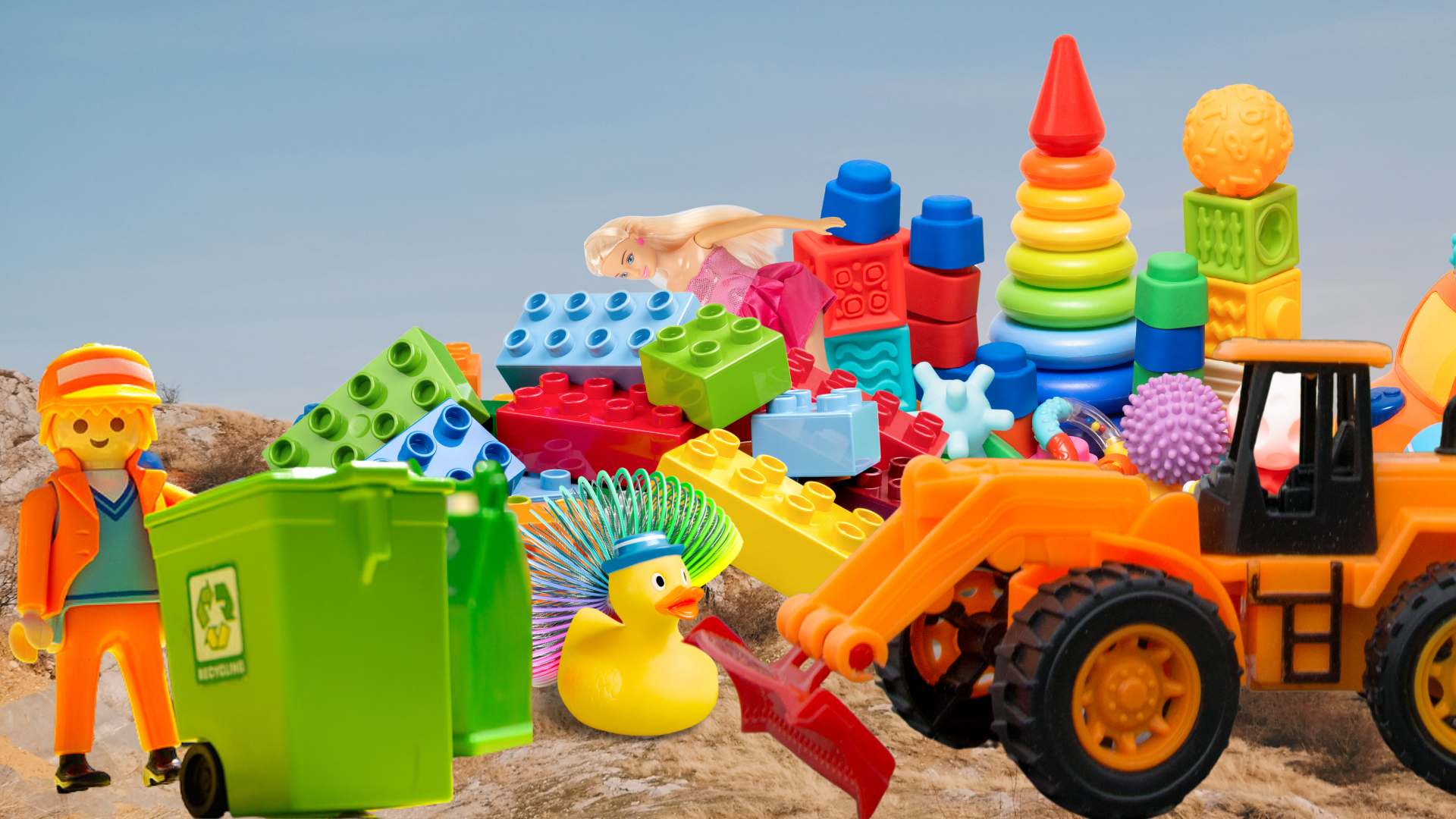The global toy industry has a plastics predicament: How to feed children’s appetite for new toys, keep prices low and not harm the Earth in the process.

A pile of plastic toys at a toy landfill. (Illustration by News Decoder)
Plastic is omnipresent in our lives and few sectors use it as extensively as the toy industry. Some 90% of the world’s new toys feature some form of plastic, which can persist in the environment for up to 500 years.
This plasticised and digitised world is a far cry from my childhood in 1990s India with its outdoor play and a handful of wooden and cloth toys.
Global toy sales reached $107.4 billion in 2022. The toy industry — $40 billion and growing in North America — has the highest plastic intensity, according to a major United Nations report on plastic use across all consumer goods. Production and packaging consumed 40 tonnes of plastic for every $1 million in toy company revenue.
Some toymakers are beginning to rethink the materials they use in toy production. And climate change activists are pushing for the development of a circular economy for toys that would increase recycling and reuse of products.
But for now, nearly 80% of all toys end up in landfills, incinerators or the ocean and account for almost 6% of landfill plastics. Plastic toys are difficult to recycle because of their complex form and chemical additives. Meanwhile, annual plastic production is expected to reach more than 56 gigatons by 2050 and account for as much as 13% of total global emissions by that time, according to one estimate.
To put that into perspective, just one gigaton is a billion metric tons or the mass of 200 million elephants.
Barbies, blocks and Lego bricks
Plastics first replaced ivory in billiard balls in 1869. They are now so pervasive because they are cheap, easy to work with and mold and come in endless combinations of flexibility, durability and weight.
This makes it perfect for the toy industry with its dolls, blocks, trucks, action figures. Any shape and texture you need, from a Lego brick to Barbie doll, plastic can do the job.
Children in Western countries have on average 18 kilos (39.6 lbs) of plastic toys each, a sign of excess consumption says Christie Klimas, an environmental science professor at DePaul University in Chicago.
“I think one of the interesting things about toys is, that in the majority of cases, they’re a luxury good, which means that they’re a non-necessity,” Klimas said. Toys often break easily and are then landfilled in most cases, she said.

Icons8 Photos)
Klimas and her students assessed the environmental impact of eight popular toys from material extraction, production and transportation. The study found that Lego’s Star Wars set had the highest greenhouse gas emissions due to the use of ABS plastic whereas the wooden gJenga had the lowest warming potential of all the toys despite weighing the most. Plastic was also found in unexpected places such as the battery cases and fur of the stuffed animals.
Toying with the planet
Plastic continues to emit greenhouse gases (in air and submerged in seawater) for an undetermined and potentially indefinite period that may contribute to climate change, according to Sarah-Jeanne Royer of the University of Hawaii. Explosion of microplastics in the environment, our ecosystems and our bodies is widely understood.
And while recycling is often touted as the solution to plastic pollution, it is broadly difficult and especially hard for toys, which typically contain many types of plastic — hard, soft and multi-coloured — and other materials.
Plastic recyclability depends on purity of the product — clear water bottles for instance — which consigns most toys to landfill or incineration. There, they join the estimated 22 million tonnes of plastic waste that enter the environment each year. Plastic pollution is a planetary threat and structural inequities in the plastics value chain make it eight times more expensive to handle for lower-income countries, according to a recent report by the World Wildlife Fund.
There has been continuing controversy about health risks with the various chemicals and compounds used to make plastics bend, twist and soften. Regulations have been introduced over the years in most of the world, but worries persist.
More than 125 out of the 419 chemicals found in hard, soft and foam plastic materials used in children’s toys could potentially harm children’s health, according to a study published in “Environmental International.” These included 31 plasticisers, 18 flame retardants and eight fragrances. Despite this, those harmful chemicals are not banned in the United States. In African and Southeast Asian countries, where cheap plastic toys are sold in unregulated and unorganised urban and rural markets, findings from studies have also reported use of toxic, life threatening chemicals in children’s toys.
A circular economy for toys
So, what exactly can we do to change how we buy, use and throw away toys and support toy industry efforts to adopt sustainable measures?
French association Rejoué has been collecting, cleaning, repairing and reselling used toys since 2012.
Many big manufacturers like Lego have taken steps towards sustainability and continue to innovate in their efforts to go green. In an email, The Toy Association, which represents 93% of U.S. toymakers, reiterated its commitment to sustainability and said it continues to work with its members on environmental protection.
Manufacturers have been experimenting with eco-friendly and recyclable materials both in toy design and packaging.
Over the next four years, Lego plans to triple its spending to $1.4 billion on a sustainability drive and is working towards making its products from more sustainable and reusable materials by 2032. It plans to pack its toys in responsibly-sourced materials that are either renewable or made from recycled content and it has started a donation program for used bricks in the United States and Canada.
Rebuilding an industry plastic brick by brick
Lego says it has tested 300 different types of materials for its products. Sugarcane-derived polyethylene, soft, durable and flexible plastic shows promise, but a two-year test of recycled polyethylene terephthalate (PET) bottles — those single-use water bottles and others — was discontinued in 2023.
The report on Plastic and Climate cautions that some approaches may seem like a solution to the plastic crisis but do little to prevent the harms to the climate or health plastics cause.
For instance, the enormous scale of fossil plastics cannot be replaced by bio-based or biodegradable plastics. And the production of these plastics can themselves cause harm and emissions from land, water and energy use.
The main culprit of the plastic problem is its sheer scale and volume which may be difficult, expensive and unlikely to be replaced by proposals such as use of organisms or chemical processes to break down and remake plastics.
Studies have found that having fewer toys is a better way to play and has enhanced creative and interactive outcomes. Companies can build longer-lasting toys that cost more so that toy companies could continue to make a profit but sell fewer toys. And those toys could then be reused within families or shared in toy libraries.
Are parents the problem?
One major factor, Klimas repeats, is the overarching problem of buying too many toys.
For Runa Goyal, who is raising an 11-year-old daughter in California, it is difficult to avoid plastic toys.
“Unless there is a solution which can beat plastic economically, things are not going to change,” Goyal said. “Although small companies like Martha and kids, which have everything made in wood, might be able to drive small change, but the whole industry is not going to change because it is economy after all.”
The price tag of greener toys is probably six to seven times a plastic toy, she said. “They’re only seen in specific places like museum souvenir shops,” Goyal said.
Research suggests that pro-environmental behavior is commonly adopted when it’s the easiest or cheapest option. Providing low-cost choices and actions to make the environmental behavior the default choice increases lower impact choices.
Making eco-friendly toys more marketable
Environmentally-friendly toys need to be better marketed so that children find them desirable.
“If one comes in a closed cardboard or say biodegradable packaging which they cannot see and feel and another in a very glossy plastic packaging where they can touch and feel and press the buttons, the children will go for it and parents will buy whatever they ask for,” Goyal said. “But if there is no choice or the eco-friendly is the only choice and the packaging is attractive, it will be bought.”
The holy grail for reducing plastic is a circular economy where toys keep circulating in a use, reuse, recycle and redesign loop. Green Toys, a U.S. manufacturer, uses only milk-bottle plastic in its products, for example. That makes the toys completely recyclable although they cost nearly one-and-a-half times or twice as much of a regular plastic toy.
Zero-waste solutions like Toy Rescue by 3D-printing company Dagoma in France are helping kids recreate parts of their favourite broken toy, thus minimising dumping and wastage.
But sustainable toys have a long way to go to replace the billions spent on conventional products.
As Kermit the Frog said: It’s not easy being green.
Questions to consider:
- Why are plastic toys so difficult to recycle?
- Why are so many plastic toys produced each year?
- What toys did you like playing with as a child? Were they environmentally-friendly?

Preety Sharma is a freelance journalist and an independent public health and development consultant currently based in Dehradun, Uttarakhand, India. She is a fellow in global journalism at the Dalla Lana School of Public Health at the University of Toronto.
Read more News Decoder stories about consumer products and the environment:
